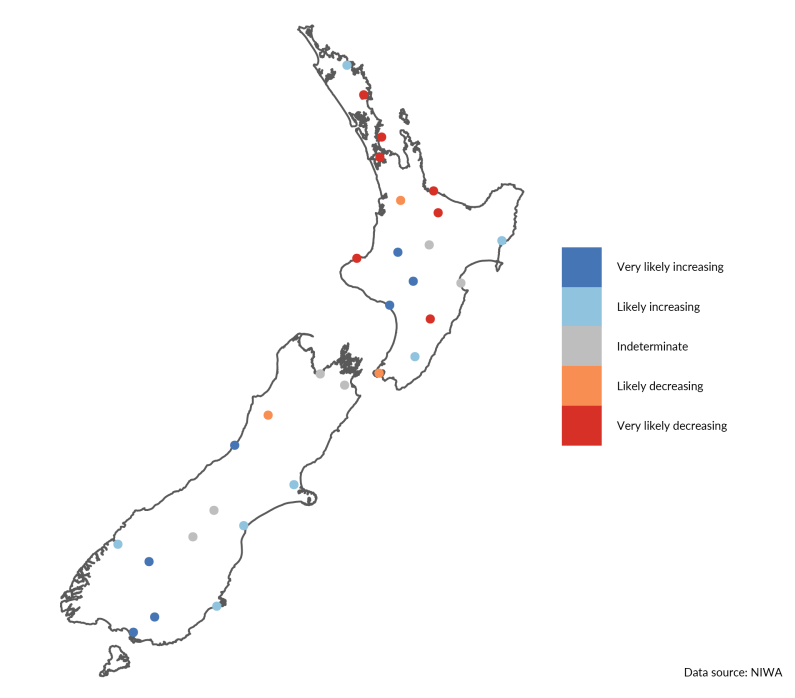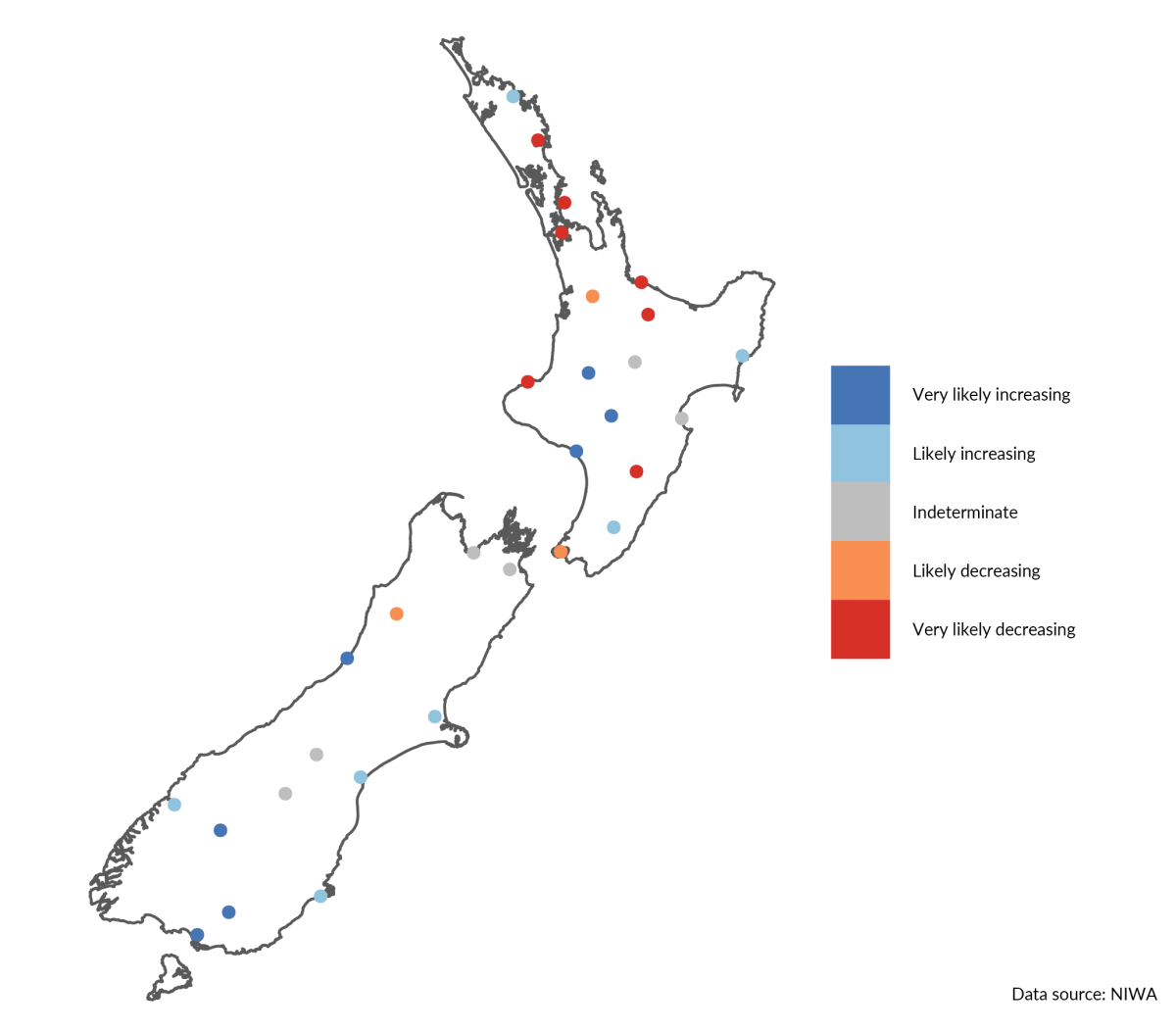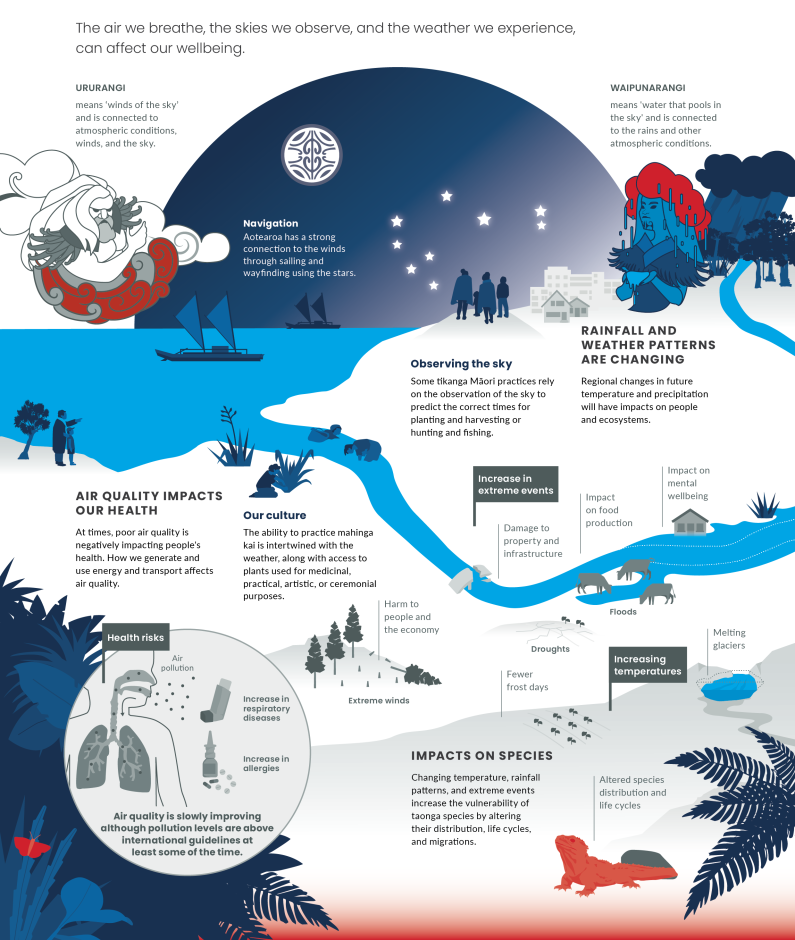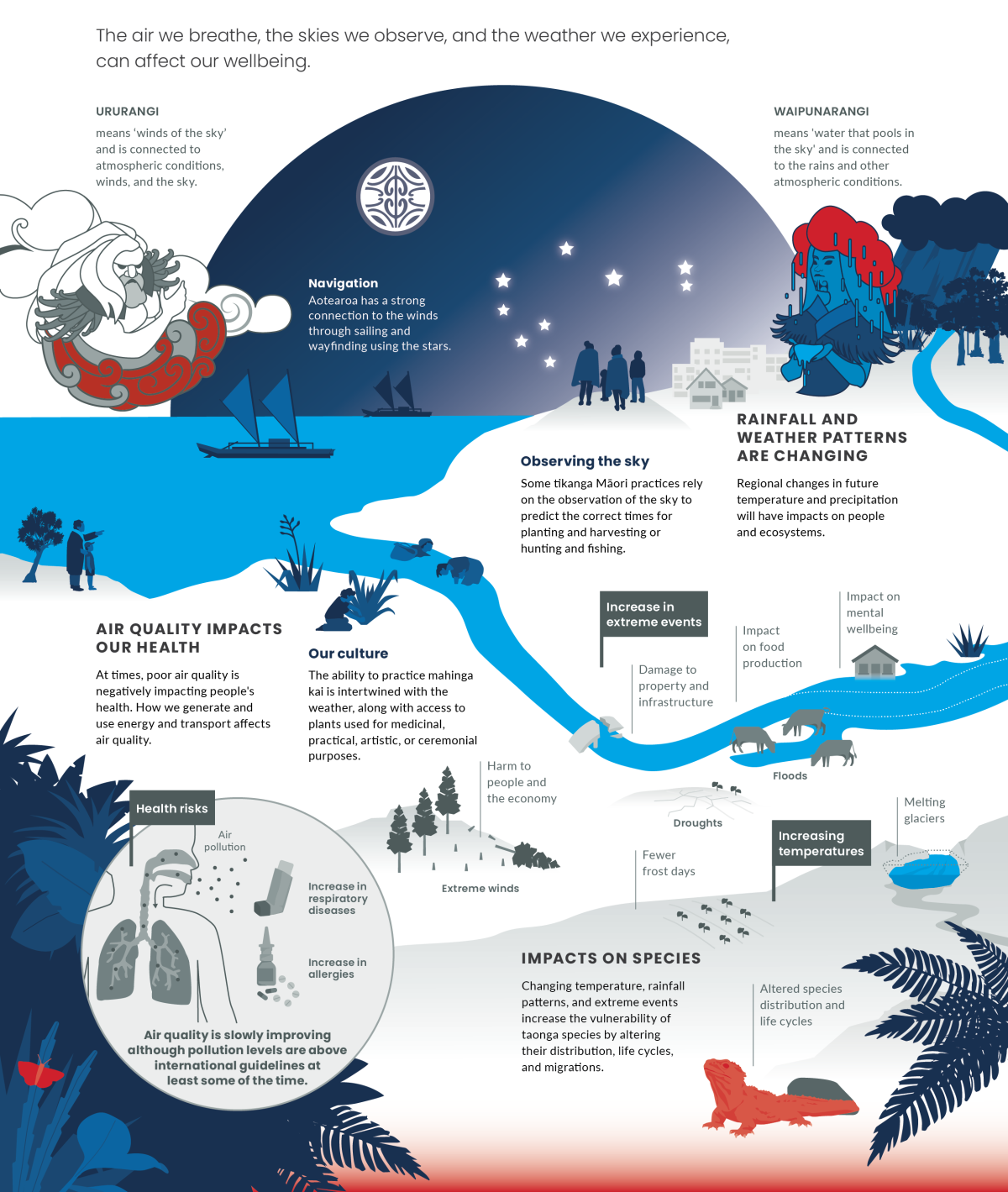Waipunarangi Rain and frosts

E tū Waipunarangi e
He ua kōnehunehu
He ua kōpatapata
He ua hūkerikeri
Behold Waipunarangi
It is a drizzle
It is a light shower
It is a deluge
Waipunarangi (Electra) is the star that is connected to the rains and other atmospheric conditions. The meaning of Waipunarangi is ‘water that pools in the sky.’ This aligns with what science tells us about the hydrological cycle, where water vapour is held in the atmosphere and then comes back to Earth’s surface as precipitation. Waipunarangi is linked to Te Ihorangi, who is the personification of rain.
The ability to forecast rain is an example of knowledge passed down through observation and oral tradition to selected custodians (Tawhai, 2013). Some believe that the projections of Waipunarangi during the rising of Matariki foretell the weather outcomes for the year ahead. If she is not visible, this signals heavy rains and possibly flooding. If she is brighter than the rest of the stars, this signals to people that rainwater should be conserved.
From a Māori perspective, the mauri of Waipunarangi is connected to the water that pools in the sky (Matamua, 2017) (see the Matariki section for the definition of mauri used in this report). As this water falls as rain, it connects Waipunarangi to the other stars of Matariki. The rains nourish Papatūānuku (Earth mother), enhancing the mauri of Tupuānuku and Tupuārangi, and flow through Waitī then into Waitā (Hakaraia, nd). A balance of water pools in the sky is important for supporting the balanced flow of mauri from Waipunarangi to the other stars. If there is too much, or too little rain, the effect of this imbalance is felt across the environment (te taiao). The mauri of each star is therefore intimately connected to the others through the waters of Waipunarangi.
The links between people and the environment can be jeopardised by a changing climate. Climate change is likely to affect tikanga Māori (customs/protocols) including the ability to practice mahinga kai (traditional food gathering practices) and rongoā (medicine), and transfer mātauranga Māori (Māori knowledge) across generations. These practices often require access to medicinal plants, and harvesting of harakeke and similar materials which are used for practical, artistic, or ceremonial purposes (Awatere et al, 2021). The availability and distribution of these species can be affected by changing climate patterns (Macinnis-Ng et al, 2021).
Climate change may also lead to the loss of customary harvesting grounds and the land used for food gardens (māra kai). For example, under warmer weather and prolonged periods of dryness we can expect an increased frequency of toxic algae blooms, which can potentially reduce the availability of key cultural species (eg kōura (freshwater crayfish)). This reduces the capability of iwi/hapū to practice manaakitanga (caring for visitors) for marae-based events and events such as funerals (tangihanga) (Awatere et al, 2021).
In addition to our geographic isolation, climate played a major role in the evolution and ecological history of the native species and ecosystems of Aotearoa (DOC, 2020a; Park, 2000). Temperature and rainfall patterns are key drivers of ecosystem function and distribution, along with the life cycles and migrations of species. Plant species have naturally adapted to their preferred climate and soil, and this results in the different types of forest that we experience in Aotearoa (Singers & Rogers, 2014; Whitehead et al, 1992). Some plant communities and species are more adaptable than others and can tolerate a range of moisture, humidity, and rainfall patterns (Singers & Rogers, 2014). Shifting weather patterns as the climate changes will put pressure on species and ecosystems that cannot adapt, while creating more suitable conditions for different species.
Changing climatic conditions can have multiple effects on species and their interactions, and these depend on their tolerance to change, habitat shifts, and migration. Shifts in the timing and severity of frosts, as well as a reduction in snowfall, are likely to create a mismatch between when plants flower and when their insect pollinators are active. This could adversely impact some plant species and strongly affect some ecosystem functions (McGlone & Walker, 2011; Renwick et al, 2016). Droughts or altered rainfall patterns can have detrimental effects on mudfish, whitebait (īnanga), bird nesting habitat in braided rivers, and macroinvertebrate communities, while also affecting kauri tree functions (Keegan et al, 2022).
Species loss due to climate may affect our wellbeing through loss of culture, sense of place, and identity (see Tupuārangi section). An assessment of 10 freshwater treasured (taonga) species found that vulnerability to changing temperature, rainfall patterns, and extreme events varies across species. Highly vulnerable taonga species include whitebait (īnanga), shortfin eel (tuna), freshwater mussels (kākahi/kāeo), banded kōkopu, and kōaro (a native fish) (Egan et al, 2020). Tuatara have been shown to be affected by an imbalance of male offspring due to increased temperature (Mitchell et al, 2006). Moderately vulnerable species include freshwater crayfish (kōura/kēwai) and giant kōkopu (Egan et al, 2020). Of the assessed species, only yellow-eye mullet (aua/kātaha) is ranked at a low level of vulnerability to climate change (Egan et al, 2020).
The frequency of masting events (the intermittent and synchronous production of large seed crops) in forest and alpine environments have been linked to changes in temperature (Kelly et al, 2013; Monks et al, 2016). In the case of beech mast, this can lead to an outbreak of pests such as rats and mice, leading to stoats breeding prolifically on abundance of food. This increase in pest numbers poses an increased threat of predation to native forest birds (King, 1983).
Other indirect climate impacts include increased vulnerability to erosion, coastal habitat squeeze (the loss of intertidal habitat due to sea-level rise and structures such as sea walls), severe fires, and changes in ocean productivity and food webs (Keegan et al, 2022; Lundquist et al, 2011; Macinnis-Ng et al, 2021).
There are still a lot of unknown direct and indirect impacts of climate change on our native species and ecosystems that need to be addressed. Mātauranga Māori, including maramataka, holds centuries of observations to understand causal effects (Hikuroa, 2017) (see Tupuānuku section). For example, oral records of changes in timing and distributions due to environmental change have been used to identify negative relationships between the El Niño Southern Oscillation and abundance of sooty shearwater (Humphries & Möller, 2017).
The agricultural sector relies heavily on rainfall and is particularly vulnerable to the extremes of both high and low rainfall. As farmland is often located on fertile floodplains it is particularly exposed to the risk of flooding (Craig et al, 2021), while water availability during drought events also poses a high risk.
Dairy farming is particularly vulnerable to flood events as it largely occurs on flat and low-lying land on floodplains, and requires regular transport of fresh milk to dairy factories. The likelihood of damages from floods is also higher for dairy farmers who rely on fixed assets, including vulnerable vegetation, farm machinery, and buildings (Craig et al, 2021). Climate change contributed to 12 extreme rainfall events in Aotearoa between 2007 and 2017, which resulted in $471 million in total insurance costs. The modelled portion of these costs attributable to human influence on climate change was estimated to be around $140 million (roughly 30 percent) (Frame et al, 2020).
Drought events can have even greater impacts on the primary sector than floods. Droughts cause the soil to dry out, and can lead to the loss of almost all of a farm’s profits (Bell et al, 2021). The two major drought events of 2007–08 and 2012–13 have been estimated by the New Zealand Treasury to incur about $4.8 billion in costs, including indirect losses (including loss of income during and following events or emergency response costs). Human influence on climate change accounted for an estimated 15–20 percent of these costs, about $800 million. These costs will almost certainly increase over time, as the climate continues to change (Frame et al, 2018, 2020).
Agriculture is one of the highest risk sectors in relation to climate change impacts due to its direct reliance on the natural environment (Arent et al, 2014). In a recent survey, 52 percent of farmers believed that severe weather and a changing climate are having a moderate or major impact on their operation, and ensuring a future supply of water was a priority for many (MPI, 2019) (see Hiwa-i-te-rangi section for more details on food and water security).
While we can estimate the likely financial impacts of floods and droughts events, it is much more difficult to assess how these events could affect mental wellbeing.
International studies have found that in the aftermath of floods, people often experience post-traumatic stress disorder (PTSD) (Cianconi et al, 2020). Floods bring mourning, displacement, and psychosocial stress due to loss of lives and belongings. A study in England found a higher incidence of depression, anxiety, and post-traumatic stress disorder in participants affected by floods (Waite et al, 2017). After the Bay of Plenty flooding in April 2017, farmers highlighted the importance of community resilience, social cohesion, and supporting others. However, respondents also reported suffering from mental health issues, in some cases necessitating time off the farm to help alleviate stress caused by the event (Paulik et al, 2021).
Throughout the world farmers are shown to be particularly susceptible to the mental health risks associated with drought (Cianconi et al, 2020). Following Australia’s decade-long drought ending in 2012, studies found an increase in anxiety, depression, and potentially suicide in rural communities. These were related to financial and employment issues, combined with feelings of helplessness and lack of optimism for the future (Albrecht et al, 2007; Polain et al, 2011).
In Aotearoa, there are very few studies examining the impact of drought on people’s wellbeing, even though it can affect mental health. This is particularly the case for those in rural areas who rely on rain for their livelihoods (EHINZ, 2021). Services are available to farmers to help with their wellbeing, such as Farmstrong (Farmstrong, nd).
Between 1960 and 2019, annual rainfall increased at 14 sites and decreased at 10 across 30 monitoring sites in Aotearoa (increases and decreases include both likely and very likely statistical trends; see indicator for trend assessment detail). Increased rainfall occurred in the southern South Island and the west coast. Many of the sites where rainfall decreased were in the northern half of the North Island (see figure 7). (See indicator: Rainfall.)

Image: Data source — NIWA

Image: Data source — NIWA
As Earth warms, scientists expect that the frequency of extreme rainfall will increase (Glasser, 2020). We have information about extreme rainfall events at 30 sites across Aotearoa between 1960 and 2019. The indicator measures the proportion that very wet days contribute to total rainfall, and the maximum amount of rainfall that fell in a single day. (See indicator: Extreme rainfall.)
The annual maximum rainfall in a single day decreased at 10 sites (seven of which are in the northern half of the North Island), while it increased at 9 of 30 sites across Aotearoa (increases and decreases include both likely and very likely statistical trends; see indicator for trend assessment detail). Trend direction couldn’t be determined for 11 sites. The proportion that very wet days contributed to total rainfall decreased at 11 sites and increased at 13. Trend direction couldn’t be determined for six sites.
Heavy rain and floods have a significant impact on landscapes and places of cultural significance, affecting communities’ ability to practice tikanga (Awatere et al, 2021). These impacts are likely to increase over time as climate change leads to increased frequency and magnitude of extreme events. Flood events impact connections and practices on, and between, marae, sites of significance (wāhi tapu), cultural infrastructure, and communities. Across Aotearoa, wāhi tapu are threatened by sea-level rise, and are being lost to flooding, storm surge, and coastal erosion.
For example, the course of the Wairoa River in Hawke’s Bay (Te Wairoa Hōpūpū Hōnengenenge Mātangi Rau) has naturally moved closer to Mātiti Urupā (burial ground). This increases the risk of erosion to the urupā from around the riverbed, particularly during significant floods. Efforts to prevent the erosion include forums (wānanga) with experts, constructing a barrier in the river and planting along the banks, but the erosion has continued (MfE & Stats NZ, 2020a).
We have information about drought at 30 selected sites across Aotearoa between 1972 and 2019. The frequency of short-term drought (those lasting three months) increased at 13 sites and decreased at 9 of 30 sites across Aotearoa over this period (increases and decreases include both likely and very likely statistical trends; see indicator for trend assessment detail). In the South Island, the majority of increasing trends in short-term drought frequency occurred in the north and east, while decreasing trends were focused in the west and south over this period of time. (See indicator: Drought.)
A study from NIWA found an overall increasing trend in low rainfall extremes, particularly on the east coast. This is consistent with a projected increase in westerly winds during winter and spring, producing drier conditions in the east (Srinivasan et al, 2021).
We have information on the number of frost and warm days for 30 sites across Aotearoa from at least 1972 to 2019. A ‘warm day’ is when the daily maximum air temperature is above 25 degrees Celsius, and a ‘frost day’ is when the daily minimum air temperature is below 0 degrees Celsius. The number of frost and warm days changes from year to year in response to climate variation, such as the warming pattern induced by El Niño. Projections from climate models indicate we may experience more warm extremes and fewer cold extremes in the future. (See indicator: Frost and warm days.)
Between 1972 and 2019, warm days increased at 24 of the 30 measurement sites, while frost days decreased at 18 of the 30 sites (increases and decreases include both likely and very likely statistical trends; see indicator for trend assessment detail). The number of heatwave days for the same period increased at 18 of the 30 sites, with some of the fastest increases happening in inland locations of the South Island. A heatwave day is defined as three or more consecutive days with a maximum temperature greater than 5 degrees Celsius above the monthly average for 1981–2010. For more detail see Our atmosphere and climate.
Glaciers are fed by snow, and hold large amounts of freshwater. Glaciers in Aotearoa decreased in volume by 35 percent between 1978 and 2020. Since our last synthesis report in 2019, annual glacier ice volumes have decreased from 40.7 cubic kilometres in 2016 to 34.6 cubic kilometres in 2020 (a loss of 6.1 cubic kilometres). (See indicator: Annual glacier ice volumes.) Glacier volume is influenced by increasing temperatures and changing rain patterns because of climate change. Changes to the ice volume in glaciers can affect river flows and ecological and hydropower resources, and cultural values.
As the planet warms, we are starting to observe changes in our rainfall patterns. Rainfall trends show decreases in the north of the North Island, and increases in the west and south of the South Island. At some locations, the frequency of short-term droughts has increased. Due to their reliance on the natural environment, our food production systems are particularly vulnerable to these changes. Changing rainfall and weather patterns add to and compound the existing pressures ecosystems are facing, having flow-on effects to all other parts of the environment and almost every aspect of our lives.

Waipunarangi means ‘water that pools in the sky’ and is connected to the rains and other atmospheric conditions.
Ururangi means ‘winds of the sky’ and is connected to atmospheric conditions, winds, and the sky.
The air we breathe, the skies we observe, and the weather we experience, can affect our wellbeing.
Rainfall and weather patterns are changing: Changes in future temperature and precipitation will have impacts on people and ecosystems.
Impacts on species: Changing temperature, rainfall patterns, and extreme events increase the vulnerability of taonga species by altering their distribution, life cycles, and migrations.
Air quality health impacts: At times, poor air quality is negatively impacting people’s health. How we generate and use energy and transport affects air quality.
Air quality is slowly improving although pollution levels are above international guidelines at least some of the time. Air pollution is linked to increase in respiratory diseases and increase in allergies.

Waipunarangi means ‘water that pools in the sky’ and is connected to the rains and other atmospheric conditions.
Ururangi means ‘winds of the sky’ and is connected to atmospheric conditions, winds, and the sky.
The air we breathe, the skies we observe, and the weather we experience, can affect our wellbeing.
Rainfall and weather patterns are changing: Changes in future temperature and precipitation will have impacts on people and ecosystems.
Impacts on species: Changing temperature, rainfall patterns, and extreme events increase the vulnerability of taonga species by altering their distribution, life cycles, and migrations.
Air quality health impacts: At times, poor air quality is negatively impacting people’s health. How we generate and use energy and transport affects air quality.
Air quality is slowly improving although pollution levels are above international guidelines at least some of the time. Air pollution is linked to increase in respiratory diseases and increase in allergies.

Waipunarangi Rain and frosts
April 2022
© Ministry for the Environment